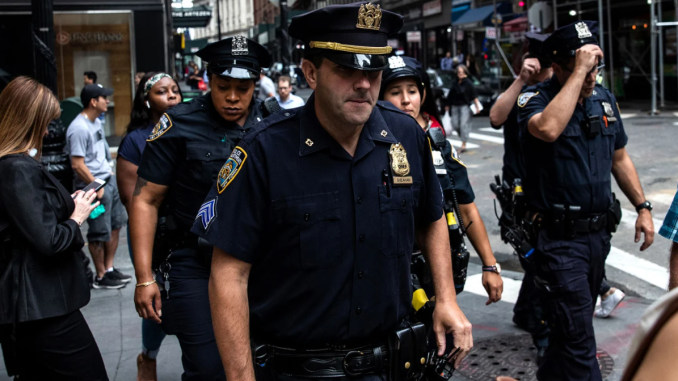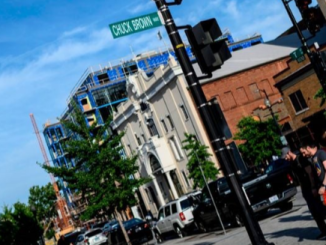
Much of the criticism of the changes in the criminal-justice system has been focused on the decriminalizing of errant behaviors and the lack of serious responses to the gun violence that plagues many urban black neighborhoods. What is largely ignored is the breakdown in lawful behavior in other less life-threatening areas: car and traffic violations, fare-beaters on public transportation, and car and store thefts.
In Chicago between 2015 and 2019, ProPublica found, households in majority-black-and-Hispanic ZIP codes received stoplight tickets at around twice the rate of those in white areas. In Rochester, N.Y., officials eliminated the city’s red-light-camera program in part because motorists from low-income neighborhoods received the most tickets and the financial harm outweighed any safety benefits. Miami ended its program amid complaints from low-income residents who felt unfairly burdened by the fines. Chicago did make one adjustment: It suspended the regulation that, after five violations, drivers’ licenses would no longer be suspended, reinstating 11,000 drivers.
A number of cities have instituted restrictions on traffic stops. Owing to bail reform, some stopped drivers may have missed court appearances. Others may have unpaid traffic violations or other outstanding legal issues. In these cases, ordinary traffic stops may lead to violent confrontations. Two high-profile incidents — Rayshard Brooks in Atlanta, and Daunte Wright in Minnesota — began with simple traffic stops that turned deadly because the suspects had more-serious charges pending. As a result, many cities, including Philadelphia, Minneapolis, and Los Angeles, have placed substantial restrictions on the ability of police officers to make stops for so-called minor infractions.
Criminal-justice reform has also substantially decriminalized store thefts. In many localities, thefts of less than $950 are considered a misdemeanor, a level that the New York Times editorial board believes is much too low. As a result, theft by repeat offenders has become more commonplace. In 2023, New York City police identified 327 people who were responsible for one-third of all shoplifting arrests. Firms have adapted by locking up some merchandise or, in some neighborhoods, abandoning franchise stores. Among many that remain, employees have been told not to confront thieves or call for police. Indeed, Lululemon fired two employees who chased a thief.
There has also been a dramatic increase in carjackings. NPR reported 405 carjackings in Minneapolis in 2020 — more than triple the number in 2019. Other cities, too, saw huge increases. Last year in Chicago, there were 1,400 carjackings. Chicago police say juveniles were involved in nearly half of the incidents year, with the largest group a mix of juveniles and young adults between 15 and 20 years old.
At least in some cities, the spike can be traced to criminal-justice reform. One of the signature changes made by Philadelphia district attorney Larry Krasner was to reduce to misdemeanor status robberies committed by youths involving property worth less than $50,000. In 2022 there were 1,300 carjackings in Philadelphia, compared with 404 carjackings in 2021 and 225 in 2019. Indeed, in December 2021 a carjacking involved Democratic congresswoman Mary Gay Scanlon.
Studies show that not all of these carjackings are driven by financial need. In a set of 50 interviews in the Chicago Tribune, Jerald McNair found that a modest share were not financially motivated: “They are doing it for the rush or the thrill,” he wrote. In the Washingtonian, Sylvie McNamara reported a similar narrative: “Young people are simply carjacking for entertainment: joyriding in stolen cars and posting about it online, escaping with limited consequences because of toothless laws, then repeatedly and remorselessly reoffending.” Echoing this viewpoint, District of Columbia police chief Robert Contee explained: “They have friends who see them do it, they do it. We’ve had young people committing carjackings and, while they’re being pursued by the police, they’re livestreaming themselves laughing.”
Another area in which lawlessness has become commonplace is that of fare-beaters on public transportation. In New York City, an estimated 700,000 individuals — more than one-third of passengers — board busses daily without paying because there is no enforcement. Bus drivers are specifically ordered not to confront fare-beaters but simply to tabulate their numbers. Police do patrol the subway system, where “only” 13 percent of passengers are fare-beaters. As a result, the transit system lost $690 million in 2022, a 38 percent spike from the previous year.
The city, however, is under pressure to find an alternative to police enforcement, since blacks and Latinos received 73 percent of the summons issued. Molly Griffard, a lawyer with the Legal Aid Society, said that resources devoted to fare evasion should be redirected to address the root causes of the behavior. Indeed, Seattle reduced its enforcement in response to equity concerns. These pressures led New York City to just make bus rides free on five routes through poorer neighborhoods.
While poverty and homelessness certainly contribute to fare avoidance in New York City and Seattle, there is evidence of a gentrification of fare-beaters. Dorothy Moses Schulz in City Journal reported that:
Janno Lieber, head of the Metropolitan Transportation Authority, recently complained that security cameras had captured . . . “countless images of people in designer clothes, carrying $7 lattes, waltzing through emergency gates at Wall Street or on the Upper East Side.” . . . The complaint echoed that of Peter Rogoff, the chief of Seattle and Tacoma’s Sound Transit, who recently singled out riders who paid for seats and $13 beers at a Mariners game but didn’t pay their fares afterward.
While it is important to have a balanced approach to law enforcement, the unwillingness to hold individuals responsible for illegal behaviors has created an environment in which lawlessness has become commonplace. It has resulted in allowing traffic infractions, store thefts, carjackings, and fare-beating to go unpunished. Is this the brave new world that social-justice advocates envisioned?
* Article From: National Review


